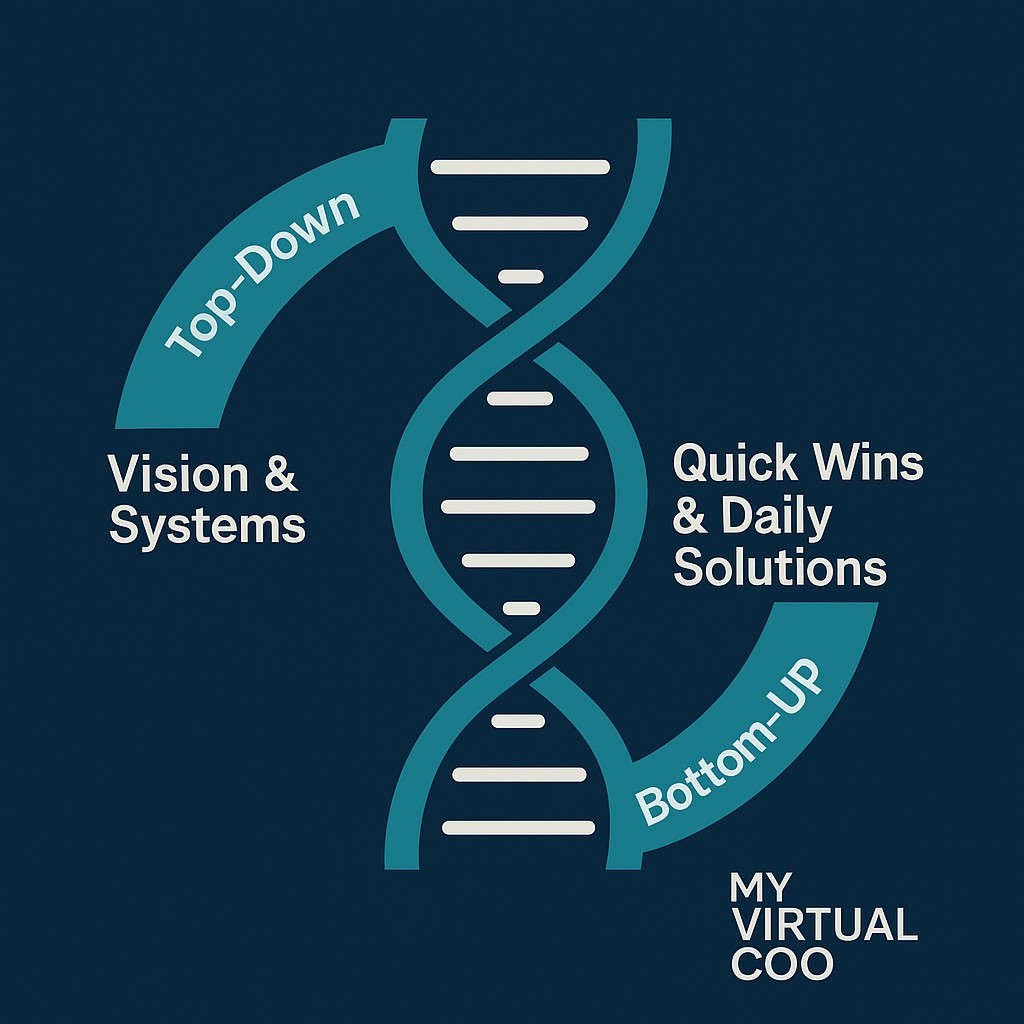In today’s fast-paced business world, success depends not only on having great products or services but also on how efficiently your team operates. Business processes and workflows are critical to the successful management of a business. They guide staff, allow easier management of the business, reduce confusion and the need for additional staff, and allow more time spent on business development and quality client interactions.
The use of effective business processes and workflows ensures staff aren’t wasting time reinventing the wheel, communicating ineffectively, or wavering from business standards. This payoff of creating processes is magnified and liberating for growing businesses that seek to manage a lean team and maintain strong profits.
Understanding Business Process and Workflows
At their core, processes are sequences of steps that guide your team to complete tasks efficiently and effectively. Processes are particularly useful for repeatable tasks that involve coordination among staff, the use of technology, and a certain order of completion. A helpful way to think of processes and workflows is to see processes as the umbrella and workflows as the spokes that help hold everything together. Understanding this terminology will help you design and implement time-saving processes that streamline your business operations and maximize productivity.
What Are Business Processes?
A business process is a set of structured activities designed to accomplish a specific organizational goal. Think of it as a recipe your team follows to deliver value to your customers.
These aren’t limited to large corporations—small businesses, startups, and even freelancers use processes every day, whether they realize it or not.
The Role of Workflows
The workflow is a series of steps that can include decision breaks. It outlines roles, timelines, dependencies, and tools used.
Business Process vs. Workflow
| Feature | Business Process | Workflow |
| Purpose | Achieves a business goal | Executes a series of tasks |
| Scope | Broad | Narrow/Specific |
| Example | Client onboarding | Sending welcome email, updating CRM |
| Owner | Department-wide or cross-functional | Task-level or individual |
The Importance of Structured Processes
Why Structure Matters
Structured business processes create consistency, reduce errors, and allow employees to focus on meaningful work instead of reinventing the wheel.
Checklist: Indicators You Need Better Processes
- Tasks are repeated differently each time
- Employees constantly seek clarity
- Quality is inconsistent
- New staff onboarding is difficult
- You’re always “putting out fires
Efficiency and Quality
According to a 2024 report by LLCBuddy, companies implementing workflow automation experience an average cost reduction of 20% and a 30% reduction in costs after implementing workflow automation.
Embracing Automation in Workflows
What Is Workflow Automation?
An “automated workflow” is a step in a process or workflow that is programmed to do the work with minimal human intervention. It’s what allows a CRM to send a welcome email the moment a client signs up or notify a manager when a deal reaches a critical stage.
Pro/Con Table: Manual vs. Automated Workflows
| Factor | Manual Workflow | Automated Workflow |
| Time Efficiency | Low | High |
| Error Rate | High | Low |
| Scalability | Limited | Extensive |
| Employee Morale | Often Frustrated | Generally Higher |
| Cost Over Time | High | Lower |
Real-World Impact
JPMorgan Chase cut service costs by 30% using AI across internal workflows.
Overcoming Challenges in Business Process and Workflow Implementation
While businesses agree that business process and workflows are necessary to build a thriving business, processes are far from universally adopted for number of reasons:
Common Barriers
- It is time-consuming to document processes
- It takes energy to get buy-in for using the processes
- Businesses lack the knowledge on where to start and what tools to use to help build processes
- Owners aren’t convinced that the effort will pay off sufficiently to merit the work involved
Fortunately, here are some solutions:
- Ask your CRM vendor for a sample workflow or process that you can practice using. This jump- starts your understanding of how to use the business process and workflows.
- Ask a member of your staff to create a short process or workflow and show it to you and the team. That starts to build buy-in.
- Choose one area of business that is time-consuming. Write information about how you manage that part of the business. Share this document with a staff member, coach or consultant and ask for advice on improving the process or how to embed it into standard operating procedures.
- Learn how processes can benefit your business by Google searching “benefits of workflows and processes” or read “Good to Great”, “Raving Fan”, Six Sigma, Jack Welch, etc. This also helps with buy-in.
- Measure progress every 30–90 days.
Holy Grail
The Holy Grail is to create automated workflows so the technology is doing the work, not you or your staff. Automated workflows allow the team to focus on meaningful client-facing activities and business development.
This saves a business a significant amount of time and money and provides mistake-proof methods to operate. Follow the same steps by asking your vendor, assigning a staff member to build automation, or relying on external support.
Shifting Staff to Rise Up
If you implement processes properly, there is a shift in staff’s responsibilities and workload. The goal of effective processes is that everyone is working at their highest skill level. This evolution of rising skills and use will allow executives to delegate work with confidence and shift their time to work ON the business.
And while processes require continuous review and improvements, the return on investment is measurable and rewarding. The staff now have processes to guide them, which reduces management and mentoring time and eliminates operations and staff headaches.
Benefits of Building Processes
Building business processes takes time, but the payoff is well worth it. Here’s how good processes benefit your business:
- Simplify training: Clear processes make it easier for new staff to understand their roles and responsibilities.
- Automate tasks: Save time by letting workflows and automation handle repetitive tasks.
- Free up staff: By automating low-value tasks, your team can focus on revenue-generating activities and higher-level work.
- Improve teamwork: Streamlined processes create a better team environment, leading to improved client satisfaction and business performance.
Process Methodology: IDEOS Approach
As you build and improve your processes, apply the IDEOS methodology to ensure the processes are optimized:
- Integrations: Can you integrate tools to reduce manual work?
- Delegation: How can tasks be better delegated using clear processes?
- Elimination: Are there steps or tasks you can eliminate through automation or streamlining?
- Outsourcing: Are there tasks you can outsource to focus on more valuable work?
- Staffing: Do roles and responsibilities need restructuring to align with more efficient methods?
Future Trends in Business Process and Workflows
Cobots and Low-Code Tools
Collaborative robots (“cobots“) are now common in manufacturing and logistics. By 2023, they made up 11% of all new industrial robots with annual sales surpassing $3 billion. Low-code platforms are also democratizing process automation, letting non-technical staff build and manage workflows.
Conclusion
Business process and workflows especially automated workflows are very important to scale a thriving, profitable business. They allow continuous reduction of work, staff working at their highest skill level, and comfort knowing the business is running smoothly.
As technology advances, those who embrace structured, automated workflows will lead in innovation, employee satisfaction, and client retention.
Frequently Asked Questions (FAQs)
What is the difference between a business process and a workflow?
A business process is a broad goal-oriented structure. A workflow is the specific series of steps taken to execute that process. For example, onboarding a new client (process) may involve gathering forms, updating databases, and sending welcome emails (workflow).
Why are business processes and workflows important for scalability?
They create structure and repeatability—critical when onboarding new staff, launching new services, or expanding geographically. Businesses without standardized workflows struggle to maintain consistency at scale.
How do I start building my first workflow?
Start small. Identify one routine task, break it into steps, map it visually or with a checklist, and test it with a teammate. Use CRM tools or platforms like Trello or Asana for basic automation.
Is automation expensive?
No. Many modern platforms offer affordable entry points for small businesses. Over time, automation often reduces costs dramatically.






